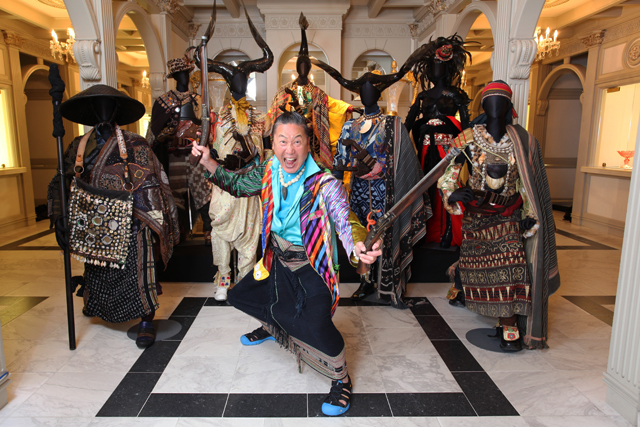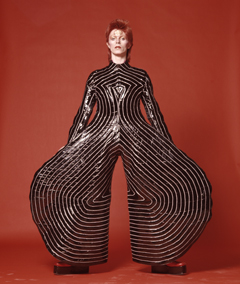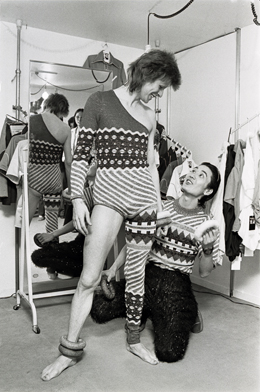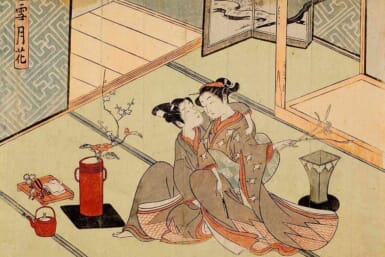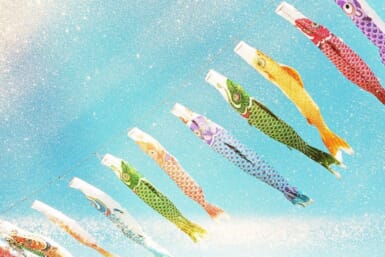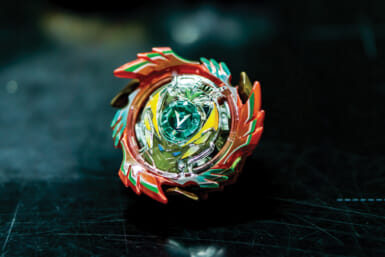One of the most flamboyant designers Japan has ever produced, Kansai Yamamoto is as eccentric as the shows he creates and as colorful as the clothes that he makes. From David Bowie’s Aladdin Sane costumes to the recently designed Keisei Skyliner express train, it seems that everything Yamamoto touches turns to gold.
Now aged 69, the Yokohama-born artist is showing no sign of slowing down and has decided to return to the world of fashion after a more than 20 year hiatus. Keen to hear more about his comeback, David Bowie and his Super Shows, Weekender recently met up with the legendary figure at his office in Aoyama. Dressed in one of his trademark psychedelic outfits, he appeared confident as he attempted his first ever interview in English.
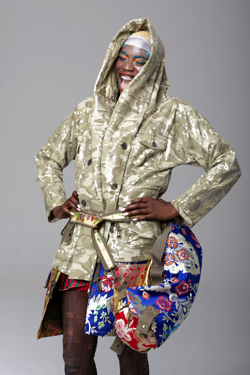
Image courtesy of Clive Arrowsmith
“I never really quit the fashion industry,” he tells us. “I continued making clothes for myself and the stage, but I just stopped creating collections for Paris and New York. Those shows took six months to prepare for, requiring all my energy and focus. I felt stuck within a framework and that is not how I like to work. You might say I am not very professional, I can’t stick to just one thing, I constantly want to be moving around, trying something new. That is why I started organizing the Super Shows and working on other projects like the Keisei Liner and the Asakusa Temple.
Everything has been going great, yet at the same time, I am a designer and last year I got that buzz for fashion again. It was during a trip to Shanghai, a city that has developed massively over the years. I sensed a real vibrancy to the place and an enormous amount of energy. It seemed like the right time to start creating collections once more.”
He presented his latest collection at ‘HELLO CHINA!!’ last September followed by ‘HELLO JAPAN!!’ in March. It is the fashion show in London’s Victoria and Albert Museum at the start of November, however, that will truly mark his return. Having made his international debut there in 1971, it is clearly a city that holds a special place in his heart.
“I recently visited London after a long absence and walking down the streets, not one day passed when someone didn’t call out to me, shake my hand or ask for a photo,” he tells us. “It was nothing to do with who I am: nobody knows who I am, it was about what I was wearing. I have a real affinity with British people. They love a little bit of craziness and this made me realise that, more than forty years on from my first show there, this was the ideal place to showcase my new collection.”
It was during that first show in England’s capital that the world first sat up and took notice of this unconventional designer. Slightly strange, but also captivating, the technique of hikinuki (taking the outer costume off to reveal an inner one) had never been seen on the catwalk before. The clothes, inspired by kabuki, were bright, bold and adventurous. Certainly not the kind of items you would expect an ordinary person to be walking around in.
“My aim was to make clothes that nobody else was attempting,” he says. “Costumes that would look great on artists who really want to express their individuality, not necessarily the general public. I have a crazy mind, always looking to have fun and generate a good atmosphere. I think this was reflected in my collections.”
Meeting Bowie
His style was perfect for the glam rock scene that was emerging in the UK at the time. Stars such as Marc Bolan (T-Rex) and Elton John were often seen in his costumes, though it was David Bowie who was most drawn to them. Describing Yamamoto’s work as “way off the board,” the charismatic singer, who would go on to become one of the most successful and revered recording artists of all time, personally commissioned the Japanese designer to create his outfits for his Aladdin Sane tour in 1973.
“I remember one of my producers, who was with me when I was doing my collection in London, she called me in the middle of the night from New York to tell me about David Bowie’s concert at Radio City Music Hall,” says Yamamoto. “Honestly speaking I didn’t have a clue who he was, but it seemed important so I changed my schedule and flew out to see his concert.
Seeing him descending onto the stage from the ceiling on a huge mirror ball wearing clothes from my female collection really surprised me. Here was a person without borders. I had never seen that androgynous look before, it was really amazing. Over the next few years I worked with a number of artists, but it was Bowie whom I forged the closest relationship with. Out of all of the designers he worked with he liked my collection the best which makes me very proud.
I don’t meet him anymore, but after listening to his new album (The Next Day) over and over, I get the impression he has matured a lot over the years. A truly unique person, I can hear his soul when he sings.”
[Contacted shortly after the death of David Bowie at 69, Yamamoto made the following statement: “David Bowie melded fashion and music completing a world of his own. His great achievements will probably continue to excite and influence new talents in others in the future. I hope that this brilliant star continues to shine above us.”]
Collaborating with David Bowie helped to raise Kansai Yamamoto’s international profile even further. Through the Seventies and Eighties the world’s biggest stars, like John Lennon and Michael Jackson were pictured in his clothes. In Japan, he and his own teachers, Junko Koshino and Hisashi Hosono, were seen as mentors and an inspiration to younger generations. Yet the man himself wasn’t satisfied, he felt that he had more to give.
Kansai Super Shows
Wanting to entertain people, he decided to launch his own Super Shows, which began in Moscow’s Red Square in 1993. It was the first time a foreigner had been given permission to stage an event there. Attracting a crowd of 120,000 people that included Russia’s President at the time Boris Yeltsin, it was the largest gathering at the Square since the victory parade in 1945 following WWII.
Featuring acrobats, dancers, musicians and various other entertainers, the shows proved to be immensely popular wherever they went. 200,000 turned up in Hanoi, Vietnam (where he proceeded with a fireworks display even though he was denied permission by the Ministry of Culture), while the show in New Delhi, India, was broadcast in 54 countries. Last year’s show in Beijing was also a huge hit, in spite of the simmering tensions between Japan and China.
All together around 3.5 million people, from all kinds of backgrounds, have been to see his spectacular events and he is not planning to stop there. He wants to produce more and is particularly interested in doing one in the Middle East.
Moving Forward
Looking to the future, Yamamoto is constantly setting himself new challenges, one of his latest being to vastly improve his English. In the past he believed it was not that important as his clothes did the talking for him. These days, however, he wants to be able to explain his collections and answer questions about them. Consequently he has been taking English lessons at Berlitz for the past seven months and it seems to be working.
Despite his secretary’s reservations he decided to do the interview in English and coped with it very well. Unprompted he veers through topics, including his vast book collection, his admiration for explorer Naomi Uemura, the two movies he watched this week (Hara-kiri and the Japanese remake of Unforgiven, both of which he highly recommends) and stories about his grandchildren. He is clearly a man that likes to talk.
“I think sometimes I speak too much,” he says laughing. “You have actually caught me on a relatively calm day. I can be like a volcano ready to erupt. Of course in some ways I have changed as I have got older, but I think in essence I have remained the same. It is very important that I keep my identity.”
He’s a larger than life character who is bristling with energy, and it is great to see Kansai Yamamoto creating collections again. Whether he can make the kind of impression he did 40 years ago remains to be seen, one thing is certain: the world of fashion is a lot more colorful with him in it.

